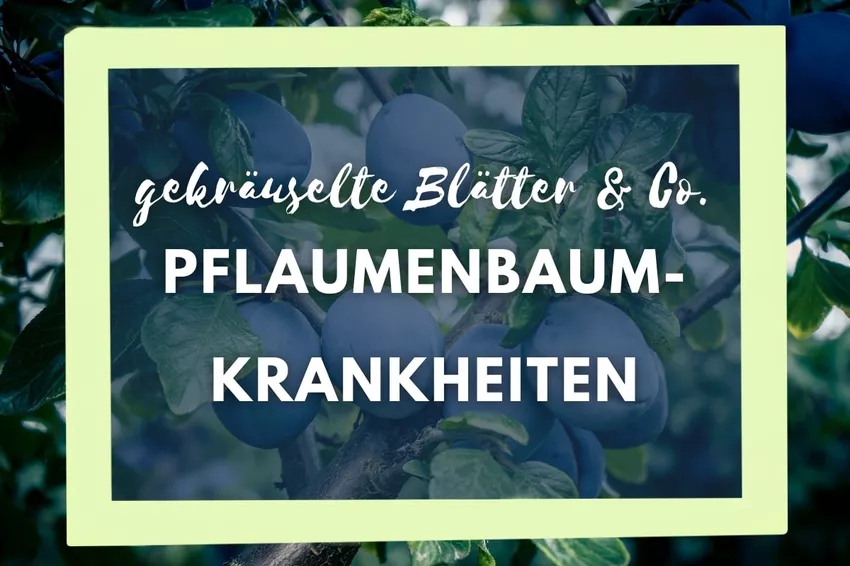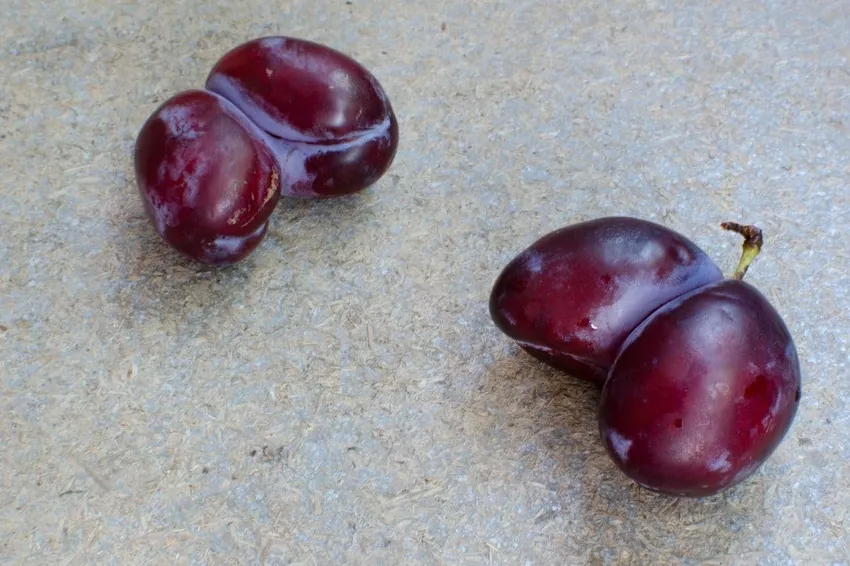
If the leaves, fruits or shoots on the plum tree (Prunus domestica) suddenly change, you need help quickly. We have compiled the most important tips for controlling plum tree diseases and pests for you.
In a nutshell
- Changes in leaves, shoots or fruits due to pests, diseases or care errors
- Monilia fruit rot and Sharka disease dangerous
- regular control to prevent diseases or treat them in time
- Professional pruning strengthens vitality and prevents diseases
- Gardening close to nature promotes the settlement of beneficial insects and prevents pest infestation
Plum Tree Diseases
Diseases of the plum tree can have various causes.
- pests
- viruses
- bacteria
- mushrooms
- Location and care errors
from A to N
bacterial burn

Symptoms:
- Grooved, black-red injuries on the trunk and branches
- in April/May these tear open and rubber flow occurs
- stunted buds
- Leaf lesions in May with shotgun-like translucent yellow-edged holes
- Trees die off in severe infections
Root cause:
- Pseudomonas syringae bacteria
Prevention or control:
- thorough removal of dead and diseased shoots
- Prune after harvest, not in winter
- Whitening of the trunk against frost cracks and infections
- Avoid cold locations
galena infestation
 The cause of galena can be the purple cartilage fungus (Chondrostereum purpureum) or a physiological disorder. Source: Jerzy Opioła, Chondrostereum purpureum G3.1n, edited by Plantopedia, CC BY-SA 3.0
The cause of galena can be the purple cartilage fungus (Chondrostereum purpureum) or a physiological disorder. Source: Jerzy Opioła, Chondrostereum purpureum G3.1n, edited by Plantopedia, CC BY-SA 3.0
Symptoms:
- green-silver sheen on leaves and twigs
- restriction of plant growth
- decrease in yield
- dying of individual parts of the tree
Root cause:
- Harmful fungus Chondrostereum purpureum
Prevention or control:
- Plant strengthening with field horsetail broth
- thorough removal of fallen leaves and diseased plant parts
double fruits

Symptoms:
- Twin fruits on a fruit stalk
Root cause:
- high temperatures during flowering
Prevention or control:
- not known
Notice: The taste of the plums is not affected by this plum tree disease.
neck wilt

Symptoms:
- Plums become soft and shrink at the top
- reduction in taste
- Cracking in the stem area
- Fruit tastes bland
- Flesh becomes crumbly
Root cause:
- frequent occurrence when changing from longer dry and wet phases in summer
Notice: The plum tree disease neck wilt mainly occurs on late varieties. Ortenauer, Hanita, Hauszwetsche and Elena are particularly susceptible.
Prevention or control:
- choose resistant varieties
Caverns and broken stones
 Caverns and broken stones are usually important exclusion criteria for the sale of the respective plum in stationary trade.
Caverns and broken stones are usually important exclusion criteria for the sale of the respective plum in stationary trade.
Symptoms:
- reddish cracks in the flesh
- Stones split or tips break off
- jellied juice inclusions
Root cause:
- inharmonious growth spurts
Prevention or control:
- choose modern, resistant varieties when planting new ones
from M to R
Monilia fruit rot

Symptoms:
- sudden fruit rot in July and August
- brown or yellow-brown, increasing spore beds on fruits
Root cause:
- Harmful fungi Monilia laxa or Monilia fructigena
Prevention or control:
- consistent removal of fruit mummies on the tree and on the ground
- Removing diseased branches
- Cut back into healthy wood
- Thin out the tree crown
Notice: Do not dispose of diseased plant parts in the compost, but in the residual waste or in the organic waste bin to prevent spread.
Fool's disease or pocket sickness
 Source: Sternrenette, fool's disease of the plum (domestic plum), edited by Plantopedia, CC BY-SA 4.0
Source: Sternrenette, fool's disease of the plum (domestic plum), edited by Plantopedia, CC BY-SA 4.0
Symptoms:
- young fruits deform and shrink
- turn greenish
- furry coating on the plums
- premature dropping of the fruit
Notice: Varieties particularly at risk from plum tree disease are: 'Ortenauer', 'Bluefree', 'President' and 'Hauszwetsche'.
Root cause:
- Harmful fungus Taphrina pruni
- humidity
Prevention or control:
- immediately remove diseased branches and fruit mummies
- Rejuvenation pruning on older trees
- Squirt horsetail or tansy broth
- Plant garlic on the tree disc
Notice: The 'Tophit' variety is considered resistant to the fool's disease.
fruit tree spider mite
 Source: \ldblquote, Red Spider, edited from Plantopedia, CC0 1.0
Source: \ldblquote, Red Spider, edited from Plantopedia, CC0 1.0
Symptoms:
- sudden leaf changes in June and July
- Leaves turn silvery or bronze
Root cause:
- Fruit tree spider mite Panonychus ulmi
Prevention or control:
- Thoroughly remove diseased plant parts
- settle beneficial insects
plum louse
 Source: Sarang, Plum leaf with Mealy Plum Aphid 2, edited from Plantopedia, CC0 1.0
Source: Sarang, Plum leaf with Mealy Plum Aphid 2, edited from Plantopedia, CC0 1.0
Symptoms:
- curling of the leaves
- pale green lice
Root cause:
- Plum louse Brachycaudus helichrysi
Prevention or control:
- Remove affected plant parts
- Spray with horsetail or garlic broth
- Remove root shoots in the fall
plum moth larva
 Source: Slimguy, 2022 08 08 Grapholita funebrana, edited by Plantopedia, CC BY 4.0
Source: Slimguy, 2022 08 08 Grapholita funebrana, edited by Plantopedia, CC BY 4.0
Symptoms:
- Stone fruit fruits falling off
Root cause:
- Plum moth Cydia funebrana
Prevent or combat:
- Shake the plum tree frequently
- discard fallen fruit
- remove affected plant parts
- spray with neem oil solution
- Attach corrugated cardboard fruit maggot catching belt
bursting of fruit

Symptoms:
- fruits tear open
- rot occurs
Root cause:
- strong rainfalls
Prevent or combat:
- choose resistant varieties
from S to U
Sharka or smallpox disease
 Sharka or smallpox disease illustrated using another plant. This plum tree disease looks similar on affected trees. Source: User:MarkusHagenlocher, Scharka Blattsymptome, edited by Plantopedia, CC BY-SA 3.0
Sharka or smallpox disease illustrated using another plant. This plum tree disease looks similar on affected trees. Source: User:MarkusHagenlocher, Scharka Blattsymptome, edited by Plantopedia, CC BY-SA 3.0
Symptoms:
- light and olive green spots on leaves in early summer
- later black dots
- premature dropping of the fruit
- pock-like depressions in the skin of the fruit
- rubbery consistency of the pulp
Root cause:
- sharka virus
- is transmitted by aphids or by grafting
- more common in long droughts
Prevention or control:
- complete control is not possible
- infected trees must be cleared
- Prevention of spread by controlling the transmitting insects
- Use of virus-free rootstocks for grafting
- Preference for less susceptible varieties
Notice: Sharka disease is that most dangerous viral disease for plums, damsons and apricots. Signs of this disease are according to the regulation for the control of Sharka disease notifiable! Sharka-tolerant varieties can become infected, but their fruits remain edible.
shotgun disease
 Shotgun disease symptoms on a cherry leaf. The clinical picture is similar in a plum tree. Source: cool grill, shotshotcherry leaf, edited from Plantopedia, CC0 1.0
Shotgun disease symptoms on a cherry leaf. The clinical picture is similar in a plum tree. Source: cool grill, shotshotcherry leaf, edited from Plantopedia, CC0 1.0
Symptoms:
- red-brown spots on young, infected leaves
- Spots fall out of the leaf tissue
- perforation of the leaves
Root cause:
- Harmful fungus Clasterosporium carpophilum
- wet weather in spring
Prevention or control:
- Thoroughly remove fruit mummies
- Dispose of diseased leaves and plant parts immediately
- Thin out the treetop
- Plant garlic on tree disc
from V to Z
Valsa toad skin disease
 Affected by Valsa toad skin disease, this branch is not a plum tree branch, but is good for illustration. Source: This image was created by user Gerhard Koller (Gerhard) at Mushroom Observer, a source for mycological images. You can contact this user here. German | espanol | french | italiano | macedonian | മലയാളം | portugues | +/−, 2012-05-26 Valsa ambiens (Pers.) Fr 223504, edited by Plantopedia, CC BY-SA 3.0
Affected by Valsa toad skin disease, this branch is not a plum tree branch, but is good for illustration. Source: This image was created by user Gerhard Koller (Gerhard) at Mushroom Observer, a source for mycological images. You can contact this user here. German | espanol | french | italiano | macedonian | മലയാളം | portugues | +/−, 2012-05-26 Valsa ambiens (Pers.) Fr 223504, edited by Plantopedia, CC BY-SA 3.0
Symptoms:
- Warty, black spots on the branches that later turn white and secrete reddish mucus
- Gum flow on trunk and branches
- rotten spots on the fruit
- branches dry up
Root cause:
- Leucostoma fungus entering the wounds
Prevention or control:
- Thoroughly remove infested parts of the plant
- Disinfect tools carefully
- Strengthening with horsetail broth
browning of the pulp
 Presumably, overheating at over 30°C in the long term leads to a collapse of the pulp.
Presumably, overheating at over 30°C in the long term leads to a collapse of the pulp.
Symptoms:
- Plums suddenly become soft and glassy just before ripening - ripening no longer progresses
- Fruits taste like cooked
Root cause:
- longer periods of heat with temperatures above 30 degrees Celsius
Prevention or control:
- choose a shady location when planting a new plum tree
Notice: Browning of the pulp often occurs together with sunburn.
plum rust

Symptoms:
- rust-colored spots and pustules on the undersides of the leaves
- mosaic-like yellow patterns on the upper sides of the leaves
- with severe infestation premature shedding of leaves
causes
- rust fungus
Prevention or control:
- Destroy nearby ornamental junipers
- Strengthen trees with field horsetail broth
- Dispose of fallen leaves thoroughly
- do not plant anemones and winterlings near plums
Notice: The rust fungus occurs regularly in humid locations in sensitive varieties. He has no influence on the edibility of the fruit.
frequently asked Questions
Which location can strengthen plum trees and protect them from diseases?Plum trees need deep soil with high water holding power. Waterlogging must be prevented by drainage. Plant the tree in a sheltered area near the house. Keep the tree grate free of weeds. Water when dry.
Which varieties are considered resistant to the sharka virus?The varieties 'Freiya' and 'Jojo' are currently the only resistant varieties. 'Opal', 'Elena', 'Kathinka' and 'Tophit' are considered Sharka tolerant.
Can diseased fruits or parts of plants be composted?Opinions differ on this question. In compost heaps, which heat up to temperatures of up to 70 degrees Celsius, most pathogens are completely destroyed. To be on the safe side, we recommend disposing of all parts affected by pests or diseases in the household waste or in the organic waste bin.